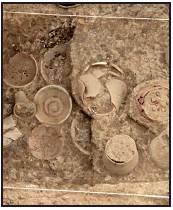5,000-yr-old Harappan trove found in Kutch
Experts Discover Burial Site With 250 Graves
Rajkot:
After two months of excavation, archaeologists have stumbled upon what they believe is a massive burial site dating back to the Harappan civilization, around 360km from Dholavira in Gujarat’s Kutch district. The find has lent further credence to the possibility of a populous human settlement at this place.

Pottery vessels inside a grave 5,000-yr-old Harappan trove found in Kutch
The excavation was done jointly by the Kutch University and Kerala University near Khatia village of Lakhpat taluka.
Estimated to be around 4,600-5,200 years old, the burial site is 300m x 300m-big with more than 250 graves, out of which 26 have been excavated. Archaeologists found one full human skeleton that is around six feet in length, estimated to be around 5,000 years old. “The skeleton has been taken to Kerala University for determining its age, possible reason for death and gender,” said Suresh Bhandari, head of Department of Archaeology, Kutch University.
This is the first time that a rectangular burial site has been found in Gujarat.
“All the burial sites found in Gujarat till date are either circular or semi-circular. We are trying to establish the significance of this rectangular shape,” added Bhandari. According to faculty members, the graves are more or less rectangular in shape with sound wall rocks in the eastwest direction. The biggest grave is around 6.9m while the smallest is around 1.2m.
Besides the human skeleton, graves of children and animal remains have also been documented from the site. Artefacts like shell bangles, grinding stones, rock blades were also recovered from the site.
The graves also contained pottery vessels — with a maximum of 19 to a minimum of three items — placed near the foot. Archaeologists said these kinds of vessels have also been found in Amri, Naal and Kot in Pakistan, Nagwada, Chatrad Saheli, Moti Pipali of North Gujarat and Surkotda and Dhaneti in Kutch.
“Geochemical analysis of all the excavated articles, including the potteries and rock blocks, will enhance our knowledge about the different techniques employed and the raw material used for making them. The items will be studied at various laboratories to know the history of people living near Khatia during the early Harappan period,” Bhandari said.
Pottery vessels inside a grave
